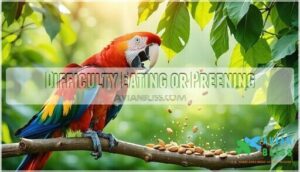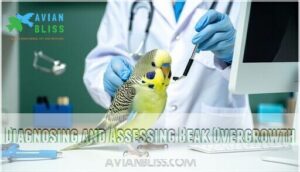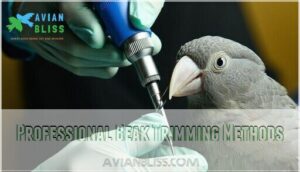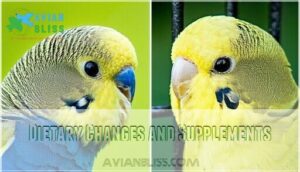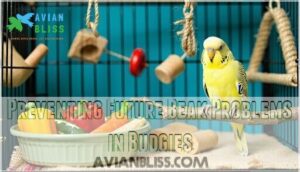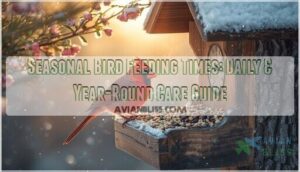This site is supported by our readers. We may earn a commission, at no cost to you, if you purchase through links.
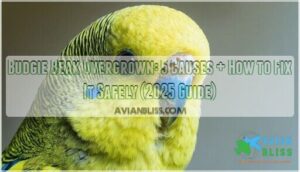
Don’t try DIY trimming—you could seriously hurt your feathered friend. Instead, visit an avian vet for safe professional trimming. Find the underlying reason with proper nutrition, chew toys, and cuttlebone.
A balanced diet with fresh veggies prevents most issues. Regular vet checks catch problems early, keeping your budgie’s beak naturally trim and healthy. Smart prevention beats costly treatment every time.
Table Of Contents
- Key Takeaways
- What Causes Budgie Beak Overgrowth?
- Signs Your Budgie Has an Overgrown Beak
- Diagnosing and Assessing Beak Overgrowth
- Safe Solutions for Treating Overgrown Beaks
- Preventing Future Beak Problems in Budgies
- Frequently Asked Questions (FAQs)
- How do you fix an overgrown budgie beak?
- Can a bird eat with an overgrown beak?
- Why does my budgie have a big beak?
- Do budgie beaks need trimming?
- How does beak overgrowth affect a budgies quality of life?
- Can beak overgrowth be a sign of underlying health problems?
- How often should a budgies beak be trimmed to prevent overgrowth?
- Can overgrown beaks grow back normally after trimming?
- How often should budgie beaks be professionally trimmed?
- Are there specific budgie breeds more prone to beak overgrowth?
- Conclusion
Key Takeaways
- Don’t attempt DIY trimming – You could seriously injure your budgie by trying to trim their beak yourself. Always visit an avian vet for safe, professional trimming using proper tools.
- Address the root cause – Beak overgrowth usually stems from a poor diet (especially seed-only diets), nutritional deficiencies, or underlying health conditions like liver disease that need veterinary treatment.
- Provide natural wear opportunities – You’ll prevent most beak problems by offering cuttlebone, varied chew toys, and textured perches that naturally keep your budgie’s beak worn down through daily use.
- Watch for warning signs early – Monitor your budgie for curved beak growth, difficulty eating, food dropping, and behavioral changes that indicate overgrowth before it becomes severe.
What Causes Budgie Beak Overgrowth?
Several things can make your budgie’s beak grow too long. Sometimes it’s as simple as diet problems, but other times you’re looking at more serious health issues.
Once you know what’s causing the overgrowth, you can tackle it head-on and stop it from coming back.
Lack of Normal Wear
Nature takes care of business, but sometimes your budgie’s beak grows faster than it wears down naturally. Without proper beak abrasion from regular activities, overgrowth becomes inevitable. This lack of normal wear patterns disrupts essential beak maintenance.
Common issues preventing natural wear:
- Insufficient chew toy options – Without varied textures to gnaw on
- Limited foraging activities – Missing opportunities for natural beak use
- Soft diet only – No hard foods requiring vigorous cracking action
Your budgie needs different textures to keep that beak in check. Think of it like filing your nails – without the right tools, things get out of hand fast.
Nutritional Deficiencies and Poor Diet
Your budgie’s diet directly affects beak health. A seed diet risks malnutrition, often causing beak overgrowth. Seeds lack essential vitamins and minerals while providing excess fat.
Vitamin deficiencies and mineral imbalance create poor nutrition consequences. Birds eating mostly seeds face numerous vitamin and mineral shortfalls.
Meeting your budgie’s dietary needs prevents these malnutrition effects. A balanced diet is vital for preventing beak growth issues in budgies.
Genetics, Breeding, and Age
Sometimes genetics plays the villain in your budgie’s beak overgrowth story. Some budgie breeds are prone to beak overgrowth due to selective breeding and genetic mutations, while age-related changes affect budgie health as they mature. Family history matters—inherited traits can pass down through generations.
- Genetic factors: Certain breeding methods increase susceptibility to beak deformities
- Age-related: Senior budgies naturally experience slower beak wear and hormonal changes
- Inherited traits: Poor breeding practices can create parakeet lineages prone to beak issues
Diseases and Infections (e.g., Liver Disease, PBFD)
When genetics aren’t the culprit, serious health conditions often trigger beak overgrowth. Liver Disease ranks as the top villain here, especially fatty liver from poor diets. This condition disrupts normal beak growth, creating soft, crumbly keratin.
Meanwhile, Psittacine Virus (PBFD) attacks budgie health systemically, causing Feather Disorders and severe Beak Infections. Young birds face higher infection risks, making early veterinary care essential for preventing these Common Illnesses in Budgies.
Regular check-ups can help identify and address parakeet health issues before they become severe.
Injuries and Trauma
When accidents happen during flight or cage activity, your budgie might suffer Beak Fractures from crashes into walls or mirrors. Head Trauma can severely impact beak growth patterns, while Wing Injuries often coincide with facial damage.
Emergency Care and immediate veterinary care become vital for trauma recovery, especially when dealing with these unexpected situations that can dramatically alter budgie health.
Signs Your Budgie Has an Overgrown Beak
A budgie’s beak that’s growing too long or changing shape will show some telltale signs. The changes happen slowly, which is why keeping an eye on your bird regularly matters so much.
Catching these issues early means you can get to a vet before your budgie starts struggling to eat or groom properly.
Visible Beak Deformities
You’ll know something’s wrong with your budgie’s beak when it starts growing in ways it shouldn’t. The changes affect how it looks and works, making everyday things like eating harder for your bird.
- Beak Shape Issues – curved, twisted, or asymmetrical growth
- Beak Color Changes – darkening, yellowing, or unusual discoloration
- Beak Growth Patterns – excessive length or uneven development
- Beak Alignment Problems – upper and lower portions don’t meet properly
When you spot any of these warning signs, don’t wait. They usually point to deeper health issues that need a vet’s attention right away.
Difficulty Eating or Preening
When your budgie’s beak isn’t aligned properly, eating difficulties and preening issues become painfully obvious. These birds struggle to grip seeds, drop food while attempting to eat, and can’t properly maintain their feathers. This impacts their overall budgie health and quality of life markedly.
| Eating Issue | What You’ll See | Impact on Budgie Care |
|---|---|---|
| Seed dropping | Food falls from beak | Poor budgie diet absorption |
| Difficulty grasping | Can’t hold pellets properly | Malnutrition risks |
| Messy feeding | Food scattered around cage | Increased cleaning needs |
| Slow eating | Takes longer to finish meals | Weight loss potential |
Behavioral Changes and Discomfort
Stress becomes your budgie’s unwelcome roommate when beak pain management becomes necessary. Changes in normal activities, like a decrease in climbing or chewing, can be a sign that the beak is causing discomfort. Your pet bird might withdraw from social interaction or start feather plucking as coping mechanisms.
- Social withdrawal from cage mates and decreased interaction with owners
- Increased aggression or irritability during handling attempts
- Repetitive behaviors like excessive scratching or head rubbing against perches
Associated Health Problems
Your budgie’s discomfort isn’t just surface-level—it often hints at bigger problems developing underneath. Beak infections can quickly spread to nearby tissues, and breathing issues might pop up when your bird starts mouth breathing instead of using their nostrils properly.
When beaks grow too long, your budgie’s body often struggles with getting enough vitamins and processing them through the liver. This creates a domino effect where one problem leads to another. Stressed birds sometimes start plucking their own feathers, making an already tough situation even worse.
Diagnosing and Assessing Beak Overgrowth
If you think your budgie’s beak looks too long, get it checked by an avian vet right away to confirm what’s happening and make sure there isn’t something serious going on underneath.
Your avian vet will assess the beak’s length, shape, and alignment while investigating potential causes like nutritional deficiencies, liver disease, or infections that require immediate treatment.
Physical Examination by a Vet
Your vet’s trained eyes can spot what you might miss during routine Veterinary Care for Budgies. Professional Avian Health Checks involve thorough Beak Inspection using specialized Diagnostic Tools that reveal underlying issues.
Here’s what happens during your Veterinary Consultation:
- Physical assessment – Your vet examines beak symmetry, length, and texture
- Weight monitoring – Sudden changes often indicate health problems
- Blood work – Tests reveal nutritional deficiencies or organ dysfunction
- X-rays – Show internal beak structure and potential abnormalities
- Behavioral evaluation – How your budgie moves and eats matters
Proper Vet Visit Preparation includes bringing your bird’s diet history and noting any behavioral changes you’ve observed recently.
Identifying Underlying Causes
Once your vet spots beak overgrowth, they’ll dig deeper into potential triggers. Dietary factors like all-seed diets or environmental influences such as cage setup often reveal themselves as culprits.
Your vet will assess genetic predisposition through family history and examine beak anatomy for trauma signs. This detective work guides treatment for best budgie health outcomes.
Safe Solutions for Treating Overgrown Beaks
So your budgie’s beak is definitely overgrown? Time to help them out—but let’s do this right.
A vet is still your best bet for trimming, but you can help your budgie naturally wear down their beak with better food choices and fun activities that get them using it more.
Professional Beak Trimming Methods
Never attempt beak trimming tools at home—this delicate procedure requires veterinary trimming expertise.
Specialized beak shaping techniques using rotary tools or nail clippers guarantee trimming safety while preserving nerve-rich tissue.
Your budgie’s health depends on professional budgie care, as improper trimming can cause bleeding or permanent damage. Trust qualified bird care professionals for safe budgie grooming procedures.
Dietary Changes and Supplements
Beyond professional trimming, fixing your budgie’s overgrown beak requires targeting the root cause through proper nutrition.
Switch from seed-only diets to high-quality pellet nutrition supplemented with fresh vegetables and fruits. Add vitamin boosters containing vitamin A, calcium, and protein to promote healthy beak growth.
Mineral supplements help strengthen beak structure, while seed alternatives provide balanced dietary needs for ideal budgie diet and nutrition.
Enrichment, Chew Toys, and Foraging
Your budgie’s habitat becomes a playground when you introduce enrichment activities that naturally trim beaks.
Rotate chew toy variety weekly—natural wood perches, cuttlebone, and rope toys provide perfect beak exercise.
Create foraging techniques by hiding budgie treats inside paper cups or wrapping them in safe materials, encouraging natural scratching and chewing that keeps beaks naturally worn down.
Preventing Future Beak Problems in Budgies
Prevention beats treatment when it comes to beak problems—hands down.
Focus on proper nutrition, keep an eye on things regularly, and give your budgie the right tools to naturally wear their beak down. Do this and you’ll keep that beak healthy for life.
Balanced Diet and Fresh Foods
After professional treatment, you’ll need to fuel your budgie’s beak health with proper nutrition. A balanced bird diet prevents future overgrowth issues.
Quality pellet options provide nutrient balance that seed alternatives can’t match. Fresh fruits and vegetables give essential vitamins, while proper water quality maintains overall health.
Your budgie diet and nutrition choices directly impact beak growth, and parrot food quality matters greatly.
Regular Beak Checks and Monitoring
Once you’ve established proper nutrition, Owner Vigilance becomes your next line of defense. Regular Checks aren’t just smart—they’re your budgie’s safety net. Here’s what budgie health monitoring looks like:
- Weekly beak inspections – Look for length changes, cracks, or unusual growth patterns
- Monthly photo documentation – Track subtle changes over time with your phone
- Daily eating observations – Notice if your budgie struggles with food or treats
- Behavioral monitoring – Watch for preening difficulties or head tilting
- Professional guidance – Schedule annual vet visits for thorough Beak Health assessments
Consistent Monitoring Tools help catch problems early, making budgie care much easier.
Providing Chew Toys and Cuttlebone
When your budgie’s beak needs constant maintenance, proper chew toy selection becomes your first line of defense. Natural wood, bamboo, and mineral blocks offer ideal textures for natural beak trimming. Cuttlebone benefits include calcium supplementation while satisfying your budgie’s instinct to grind their constantly growing beaks.
| Enrichment Type | Purpose |
|---|---|
| Natural Wood Toys | Daily beak maintenance |
| Cuttlebone | Calcium + grinding surface |
| Foraging Techniques | Mental stimulation |
| Lava Blocks | Rough texture trimming |
Smart budgie habitat enrichment prevents overgrowth naturally.
Routine Veterinary Care and Advice
For your budgie’s health and wellbeing, annual veterinary checkups aren’t just recommended—they’re essential. These visits monitor beak maintenance and bird nutrition while catching subtle health problems early.
Your vet will assess budgie health conditions, discuss proper avian hygiene, and identify signs of a healthy budgie that guarantee your feathered friend thrives.
Frequently Asked Questions (FAQs)
How do you fix an overgrown budgie beak?
Visit an avian vet immediately for professional trimming using a Dremel tool. Don’t attempt DIY fixes. Meanwhile, provide cuttlebone and balanced pellet diet to prevent future overgrowth.
Can a bird eat with an overgrown beak?
Yes, but with serious difficulty. Birds with overgrown beaks struggle to pick up food, drop food frequently, and have trouble feeding. This leads to malnutrition and requires immediate veterinary care.
Why does my budgie have a big beak?
Your budgie’s beak might look oversized due to overgrowth from malnutrition, particularly seed-only diets lacking essential vitamins.
Liver disease, mites, or lack of chewing toys can also cause this issue, requiring veterinary attention.
Do budgie beaks need trimming?
Picture your budgie’s tiny curved beak gently cracking sunflower seeds. Healthy budgies shouldn’t need trimming as daily use maintains them properly.
However, your vet should handle any trimming if overgrowth occurs.
How does beak overgrowth affect a budgies quality of life?
Your budgie’s overgrown beak greatly impacts their daily life. They might struggle to eat, drool excessively, lose weight, or even become lethargic or irritable.
Making proper veterinary care essential for their comfort.
Can beak overgrowth be a sign of underlying health problems?
Absolutely—beak overgrowth often signals serious underlying issues. Malnutrition, liver disease, viral infections like PBFD, and vitamin deficiencies can all trigger abnormal beak growth, requiring immediate veterinary attention.
How often should a budgies beak be trimmed to prevent overgrowth?
Healthy budgies usually don’t need regular beak trims. If overgrowth occurs, trimming may be needed every 1-12 months depending on severity. Consult your avian vet for proper assessment.
Can overgrown beaks grow back normally after trimming?
Like a phoenix rising from ashes, trimmed beaks do grow back normally. However, your bird’s beak continues growing like fingernails, so addressing underlying causes—poor diet, liver disease, or nutritional deficiencies—ensures healthy regrowth and prevents future problems.
How often should budgie beaks be professionally trimmed?
Normally, healthy budgies won’t need professional beak trimming.
If your bird has an overgrown beak, regular beak corrections may be required every 1–12 months, but this indicates an underlying health issue requiring veterinary evaluation first.
Are there specific budgie breeds more prone to beak overgrowth?
Not really—beak overgrowth affects all budgie varieties equally. The culprit isn’t breed genetics but rather poor diet, lack of chewing materials, or underlying health issues that impact any budgie.
Conclusion
Remember, "an ounce of prevention is worth a pound of cure" when dealing with budgie beak overgrown issues. Proper diet, regular vet visits, and enrichment activities keep your bird’s beak naturally worn down.
Prevention is worth a pound of cure when it comes to budgie beak health
Don’t attempt DIY trimming—always seek professional help for safe treatment. By providing cuttlebone, varied textures, and monitoring your budgie’s eating habits, you’ll prevent most beak problems before they start.
Your feathered friend deserves the best care possible.
- https://budgiefly.com/budgies-beak-care-guide-tips-tricks-for-healthy-beak-maintenance/
- https://www.entomoljournal.com/archives/2021/vol9issue1/PartY/9-1-311-602.pdf
- https://www.reddit.com/r/budgies/comments/16zswcd/8yr_old_budgie_beak_is_ridiculously_long/
- https://lafeber.com/pet-birds/questions/birds-beak/
- https://www.nature.com/articles/laban0306-19


